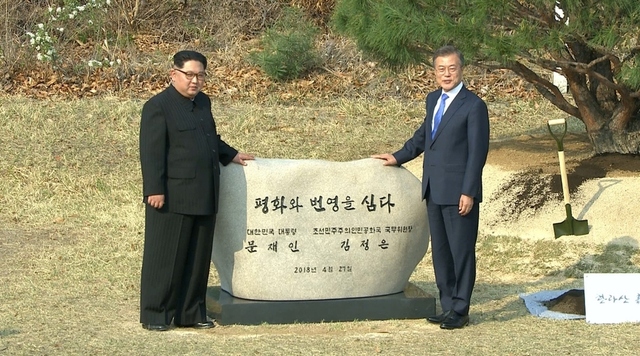 |
|
South Korean President Moon Jae-in and North Korean leader Kim Jong-un pose for a commemorative photograph after jointly planting along a pine tree in the vicinity of the Military Demarcation Line in Panmunjeom following their summit on Apr. 27. (by Kim Kyung-ho, staff photographer)
|
Panmunjeom Declaration lays important groundwork in advance of US-North Korea summit
In their Apr. 27 “Panmunjeom Declaration for the Peace, Prosperity, and Unification of the Korean Peninsula,” South Korean President Moon Jae-in and North Korean leader Kim Jong-un said they had “confirmed the common goal of realizing, through complete denuclearization, a nuclear-free Korean Peninsula.” Denuclearization had been the main agenda item among three determined beforehand by South and North Korea for the summit, as well as a major focus of attention ahead of the North Korea-US summit. If the “complete denuclearization” agreed to by Moon and Kim represents a comprehensive methodology, then the “nuclear-free Korean Peninsula” could be said to represent the final goal. While the declaration did not include technical or specific terms, the two leaders can be viewed as having laid important groundwork for a successful North Korea-US summit. The two leaders also said in the declaration that the South and North Korean sides would “carry out their respective roles and responsibilities” while sharing “the view that the measures being initiated by North Korea are very meaningful and crucial for the denuclearization of the Korean peninsula.” “South and North Korea agreed to actively seek the support and cooperation of the international community for the denuclearization of the Korean Peninsula,” they declared, signaling that Moon and Kim plan to continue cooperating closely as they work on a solution to the issue. With the two leaders believed to have discussed an even more concrete and comprehensive solution on the denuclearization issue than what was included in the Panmunmjeon Declaration, the big focus for observers now is on what happens next. Moon and Kim had a “closed-door meeting in the open” at their summit, spending around 40 minutes walking along a pedestrian bridge over the Panmunjeom wetlands. During their walk, the two are likely to have shared their feelings and held intensive discussions on ideas for denuclearization, normalization of North Korea-US relations, and the adoption of a peace agreement in place of the current armistice agreement and establishment of a permanent peace regime on the Korean Peninsula. The more general language used in their declaration that day was seen as a strategic move reflecting the upcoming summit set to take place between Kim and US President Donald Trump in May or early June. In addition to the abandonment of “future nuclear weapons” including the Punggye Village nuclear test site shutdown, which was announced by Kim at a Korean Workers’ Party Central Committee plenary session on Apr. 20, the matters of present and past nuclear capabilities are a key bargaining chip for Kim in his attempts to secure guarantees from Trump on his regime’s security. “They sent a positive signal by including ‘complete denuclearization’ [in the declaration],” said University of North Korean Studies professor Koo Kab-woo. “In terms of ‘CVID’ [complete, verifiable, and irreversible denuclearization], the ‘verifiable’ and ‘irreversible’ parts are matters to be negotiated with the US,” he added. Indeed, Trump and other figures in his administration have recently been using the term “complete denuclearization” instead of “CVID” – a move that has many curious about the reasons for the change. By Kim Ji-eun, staff reporter Please direct questions or comments to [english@hani.co.kr]






